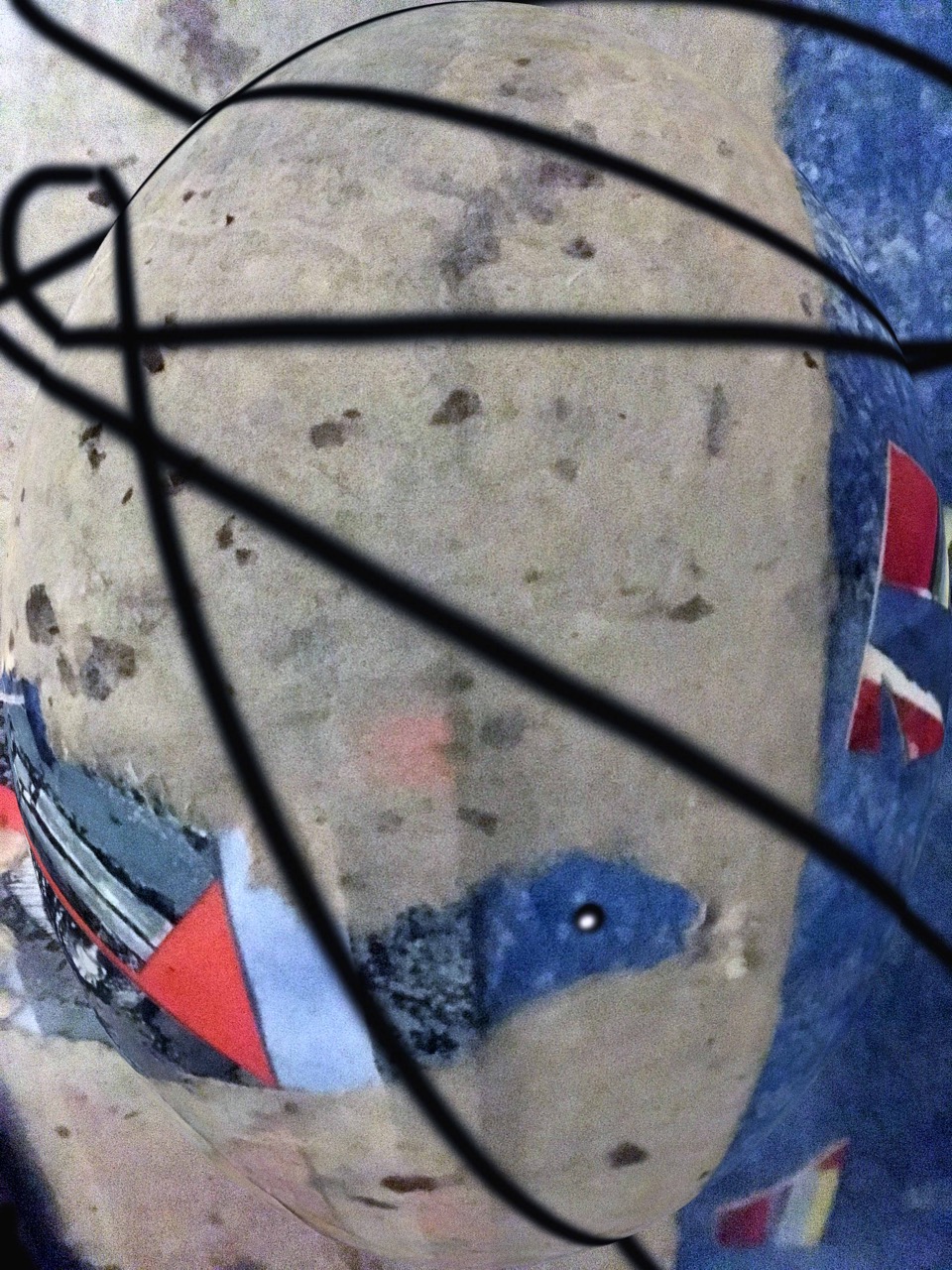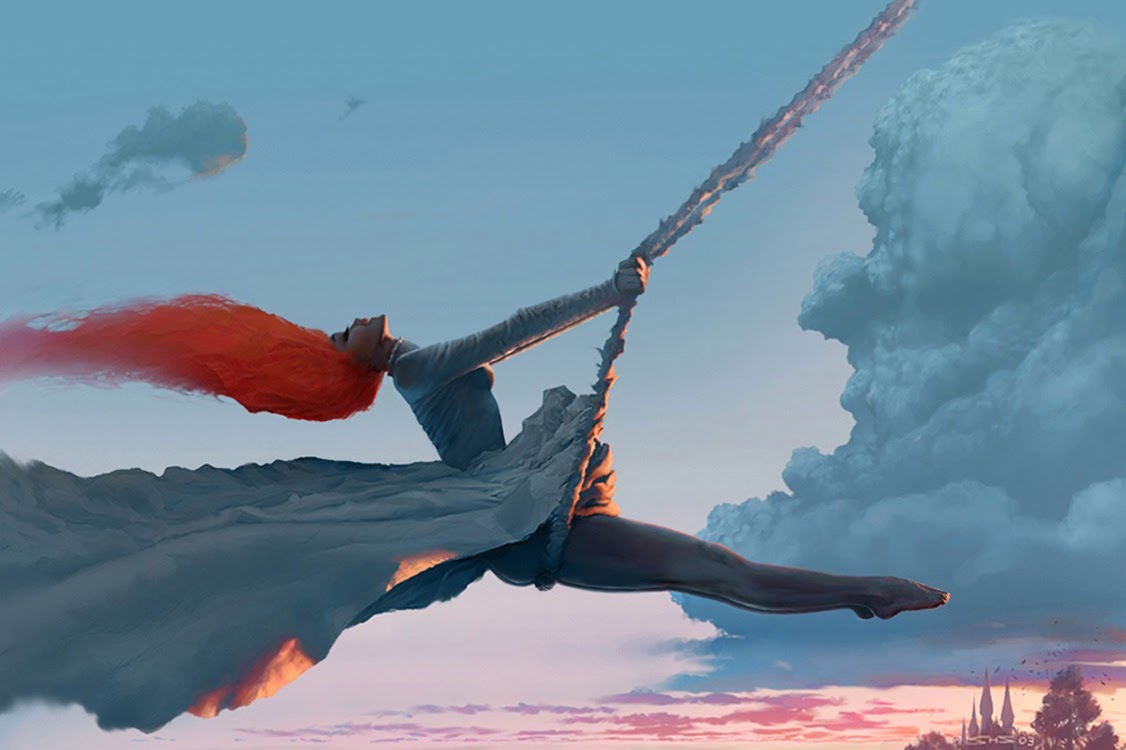Silence (30) by Mai Văn Phấn
Explicated by Dr. Ramesh Chandra Mukhopadhyaya
Translated into French by Dominique de Miscault
Translated into Vietnamese by Takya Đỗ

Tranh của HS. Dominique de Miscault
Silence
30
A garden
A ditch
A quiet and transparent
Space
A butterfly
Red and lonely
Glides
And flutters
It lands on a tree top
No
It is not lonely
The butterfly is a flower
From this space, this ditch, and this garden…
It lands
To shut down time
For the flower to become a bud.
(Translated from Vietnamese by Nhat-Lang Le & Susan Blanshard)
Explication
A wonderful poem laden with all the wealth of fairy tales and magic and more. The poem opens with a landscape. It is a garden. There is a ditch. The ditch may be inside the garden or outside the garden. If the ditch is around the garden or outside the garden it suggests the chasm between our mundane world and the garden. The garden is cosmos as opposed to the world we experience which is chaos. Because the garden is quiet and transparent space. And no wonder one has to go across lot of difficulties and penance or the ditch to reach the garden charged with tranqIuility. The space or the garden is transparent. It hides nothing from the eye. Astro nauts who move in the space have their eyes remodeled. And when nebulas are fully ionized everything becomes transparent in a space unpolluted by light. Well poets have also remodelled eyes before which space could be transparent. And in that garden space which is transparent the poet finds a lonely butterfly gliding and fluttering. The butterfly is red. In any dream whatever the dreamer exists in some disguise. One knows not whether the poet unconsciously projects himself as the butterfly. Because a poet like a butterfly cannot but be drawn to the nectar inherent in all things both great and small. Besides a truly great poet helps in the creative process in the existence just as a butterfly is essential in pollination. Red in Vietnamese culture means happiness love luck celebration etc. The poet stands for love luck and celebration. The butterfly glides and flutters. To glide is to make an unpowered flight. The poet also writes with effortless ease. The poet also hovers by flapping his words quickly and lightly sometimes.
Finally the butterfly lands on a tree. The action we must remember takes place in a tranquil garden of mind where space is transparent. And one wonders whether the tree on which the butterfly alights is the tree of life. And it is no longer lonely. We know how caterpillars become butterflies. It is not magic. It is real. Similarly a butterfly could metamorphose into a flower. The flower is a receptacle. A butterfly is the thing contained in it. Curiously enough the thing that fills a container becomes the container itself. And lo! The butterfly lands to shut down time so that the flower becomes a bud. And thus poem literally becomes a conundrum. On one level the butterfly lands on the flower to shut down time. A thing of beauty becomes joy for ever. So time is shut down. Because no longer there is the sequence of time. The present becomes eternity which is timeless. But on another level the butterfly becomes the flower and the flower becomes the bud. That is time becomes retrograde. If one moves faster than light he moves from today to yesterday. But no poet perhaps decodes the mystery of rebirth. As soon as there iare old age and maturity time becomes retrograde for one. One turns into a zygote to begin life anew. The flower after its full efflorescence turns into a bud again. But such visions are not possible in the mundane world. Our minds become crowded with hazy nebulas of desire hatred anger and the like. In the garden across the ditch space is transparent unpolluted by desire. And once one reaches the garden, one comes across transparent space where the workings of the butterfly or time are clearly descried. May be the garden could remind us the readers of the realm of Amitabha or Amida. The poem thus remodels our eyes so that we can experience both the physical and meta physical reality. Such poems are very rare in world literature.
Tĩnh lặng (30) của Mai Văn Phấn
Ramesh Chandra Mukhopadhyaya chú giải
Takya Đỗ dịch sang tiếng Việt
30
Vườn cây
Dòng mương
Khoảng không lặng im
Trong suốt
Con bướm màu đỏ
Lạc lõng
Bay tung tăng
La đà
Đậu xuống đỉnh cây
Không
Nó không lạc lõng
Cánh bướm là bông hoa
Của khoảng không, dòng mương, vườn cây...
Đậu xuống
Khép lại thời gian
Cho bông hoa thành nụ.
Chú giải:
Một bài thơ tuyệt tác đầy ắp những câu chuyện cổ tích và phép màu và còn hơn thế nữa. Bài thơ mở ra với một khung cảnh. Đó là một khu vườn. Nơi ấy có dòng mương. Dòng mương có thể nằm trong khu vườn này mà cũng có thể nằm bên ngoài cũng nên. Nếu dòng mương chạy quanh khu vườn hoặc nằm bên ngoài khu vườn, nó gợi ra một vực thẳm ngăn cách giữa thế giới trần tục của chúng ta và khu vườn ấy. Khu vườn là vũ trụ trật tự hài hòa tương phản với cái thế giới mà chúng ta đang trải nghiệm, một thế giới hỗn loạn. Vì rằng khu vườn là một không gian tịch lặng và trong suốt. Và sẽ chẳng ai lấy làm lạ khi một người phải vượt qua rất nhiều khó khăn và ăn năn sám hối hay vượt qua dòng mương kia để đến được khu vườn ngập tràn thanh tịnh đó. Không gian hay khu vườn đó trong suốt. Nó chẳng hề che giấu điều gì với con mắt ngắm nhìn. Khi du hành vào không gian, cặp mắt của các nhà du hành vũ trụ đã bị biến đổi khúc xạ. Và khi những tinh vân đã bị ion hóa hoàn toàn thì mọi thứ trở nên trong suốt trong một không gian không bị ánh ánh sáng làm vẩn đục. Các nhà thơ cũng biến đổi mắt nhìn của mình như vậy, để trước cặp mắt đó không gian có thể trở thành trong suốt. Và trong cái không gian trong suốt của khu vườn kia, nhà thơ thấy một con bướm lạc lõng, bay tung tăng, la đà. Con bướm ấy màu đỏ. Trong bất kì giấc mơ nào, người đang mơ cũng ở trong một cái lốt nào đó. Ai biết được rằng nhà thơ trong vô thức có đang tưởng mình hóa bướm hay không. Vì lẽ một nhà thơ cũng như một con bướm không thể không bị thu hút bởi bầu mật ngọt vốn ẩn chứa trong lòng vạn vật bất kể lớn nhỏ. Vả lại, một nhà thơ thực sự tài hoa sẽ giúp ích cho quá trình sáng tạo trong hiện tồn giống như con bướm là yếu tố thiết yếu trong quá trình thụ phấn. Màu đỏ trong văn hóa Việt Nam tượng trưng cho hạnh phúc, tình yêu, sự may mắn, lễ hội, v.v.. Nhà thơ tượng trưng cho tình yêu, sự may mắn và lễ hội. Con bướm bay tung tăng, la đà. Bay tung tăng tức là bay lượn nhẹ nhàng không cần vận lực. Nhà thơ cũng viết theo mạch tự nhiên phiêu dật. Nhà thơ cũng phiêu diêu vỗ đôi cánh ngôn từ lúc nhặt lúc khoan.
Cuối cùng con bướm đậu xuống ngọn cây. Nên nhớ hành động này diễn ra tại một khu vườn thanh tĩnh trong tâm thức nơi không gian trong suốt. Và người ta chẳng khỏi băn khoăn phải chăng cái cây mà con bướm đậu xuống đó là cây sự sống? Và nó không còn lạc lõng. Chúng ta đã biết những con sâu hóa bướm ra sao. Đó không phải phép màu. Đó là thực tại. Tương tự như vậy, con bướm cũng có thể biến thành bông hoa. Bông hoa là nơi chứa đựng. Con bướm là vật được chứa trong bông hoa đó. Thật kì lạ là cái vật được chứa trong vỏ đựng lại trở thành chính cái vỏ đựng ấy. Và kìa! Con bướm đậu xuống để khép lại thời gian cho bông hoa thành nụ. Và bằng hình ảnh ấy bài thơ trở thành một câu đố theo đúng nghĩa. Một mặt, con bướm đậu xuống bông hoa để khép thời gian lại. Một vật xinh đẹp trở thành niềm vui bất tuyệt. Thế nên thời gian khép lại. Bởi dòng thời gian không còn tiếp diễn. Hiện tại đã trở thành vĩnh hằng không chịu ảnh hưởng của thời gian. Nhưng mặt khác con bướm lại biến thành bông hoa và bông hoa thành nụ. Đó là khi thời gian bắt đầu nghịch hành. Nếu một người di chuyển với tốc độ nhanh hơn ánh sáng, thì người đó đi từ ngày hôm nay sang ngày hôm qua. Song có lẽ chẳng có nhà thơ nào giải mã sự huyền bí của luân hồi. Ngay khi có tuổi và trở nên chín chắn, thời gian bắt đầu nghịch hành đối với mỗi người. Người ta biến thành một hợp tử để bắt đầu cuộc đời mới. Bông hoa sau khi đã mãn khai lại một lần nữa trở thành nụ hoa. Nhưng những ảo cảnh như thế không thể có trên cõi phàm này được. Tâm trí ta dày đặc những đám tinh vân mờ mịt bởi thất tình lục dục. Trong khu vườn bên kia dòng mương là không gian trong suốt không bợn chút bụi trần. Và khi người ta đến được khu vườn, người ta đi xuyên qua không gian trong suốt là nơi có thể thấy rõ chuyển động của con bướm hoặc thời gian. Khu vườn đó có thể khiến độc giả chúng ta liên tưởng đến cõi Cực lạc của Đức Vô lượng quang Phật hay Đức Phật A di đà. Bài thơ theo cách ấy đã biến đổi khúc xạ cặp mắt chúng ta để ta có thể trải nghiệm cả thực tế vật chất lẫn thực tế siêu hình. Những bài thơ như vậy thật hiếm có trong nền văn học thế giới.

Ts. Ramesh Chandra Mukhopadhyaya
Dr. Ramesh Chandra Mukhopadhyaya
Address: 6/ 1 Amrita Lal Nath lane P.0. Belur Math Dist Howrah West Bengal India Pin code711202. Date of Birth 11 02 1947. Education M.A [ triple] M Phil Ph D Sutrapitaka tirtha plus degree in homeopathy. He remains a retired teacher of B.B. College, Asansol, India. He has published books in different academic fields including religion, sociology, literature, economics, politics and so on. Most of his books have been written in vernacular i.e. Bengali. Was awarded gold medal by the University of Calcutta for studies in modern Bengali drama.
TS. Ramesh Chandra Mukhopadhyaya
Địa chỉ: 6/ 1 đường Amrita Lal Nath hòm thư Belur Math Dist Howrah Tây Bengal Ấn Độ mã số 711202. Ngày sinh: 11 02 1947. Thạc sĩ văn chương, thạc sĩ triết học, tiến sĩ triết học [bộ ba] cùng với Bằng y học về phép chữa vi lượng đồng cân. Ông còn là một giảng viên đã nghỉ hưu của Trường đại học B.B, Asansol, Ấn Độ. Ông đã có những cuốn sách được xuất bản về nhiều lĩnh vực học thuật bao gồm tôn giáo, xã hội học, văn học, kinh tế, chính trị v.v. Hầu hết sách của ông đã được viết bằng tiếng bản địa là tiếng Bengal. Ông đã được tặng thưởng huy chương vàng của Trường đại học Calcutta về các nghiên cứu nghệ thuật sân khấu Bengal hiện đại.

Nhà thơ - Nghệ sỹ Dominique de Miscault
Poétesse - Artiste Dominique de Miscault
Artiste Plasticienne. Actualités. De plages en pages qui se tournent. C’était hier, de 1967 à 1980, mais aussi avant hier. puis de 1981 à 1992. Et encore de 1992 à 2012 bien au delà des frontières. Aujourd’hui, la plage est blanche sous le bleu du soleil. Ecrire en images, cacher les mots porteurs de souffrance ; on ne raconte pas les pas d’une vie qui commence en 1947. C’est en 1969 que j’ai été invitée à exposer pour la première fois. Depuis j’ai eu l’occasion de « vagabonder » seule ou en groupe en France et dans le monde sûrement près de 300 fois. Les matériaux légers sont mes supports, ceux du voyage et de l’oubli.
www.dominiquedemiscault.fr
www.dominiquedemiscault.com
www.aleksander-lobanov.com
Nhà thơ - Nghệ sỹ Dominique de Miscault
Nghệ sĩ nghệ thuật thị giác đương đại. Từ bãi biển đến trang giấy. Là ngày hôm qua, từ 1967 đến 1980, và trước đó, rồi từ 1981 đến 1992. Và nữa từ 1992 đến 2012 trên tất cả các biên giới. Ngày hôm nay là bãi biển trắng dưới bầu trời xanh. Viết bằng hình ảnh, giấu từ ngữ mang nỗi đau, người ta không kể lại những bước đi trong cuộc đời tính từ năm 1947. Vào năm 1969, lần đầu tiên tôi được mời triển lãm tác phẩm. Kể từ đó, tôi có cơ hội một mình "lang bạt" hoặc theo nhóm ở nước Pháp và khắp nơi trên thế giới, chắc chắn gần 300 lần. Những chất liệu nhẹ là nguồn hỗ trợ tôi, những chất liệu của hành trình và quên lãng.
www.dominiquedemiscault.fr
www.dominiquedemiscault.com
www.aleksander-lobanov.com
Tĩnh lặng - Silence (1)
Tĩnh lặng - Silence (2)
Tĩnh lặng - Silence (3)
Tĩnh lặng - Silence (4)
Tĩnh lặng - Silence (5)
Tĩnh lặng - Silence (6)
Tĩnh lặng - Silence (7)
Tĩnh lặng - Silence (8)
Tĩnh lặng - Silence (9)
Tĩnh lặng - Silence (10)
Tĩnh lặng - Silence (11)
Tĩnh lặng - Silence (12)
Tĩnh lặng - Silence (13)
Tĩnh lặng - Silence (14)
Tĩnh lặng - Silence (15)
Tĩnh lặng - Silence (16)
Tĩnh lặng - Silence (17)
Tĩnh lặng - Silence (18)
Tĩnh lặng - Silence (19)
Tĩnh lặng - Silence (20)
Tĩnh lặng - Silence (21)
Tĩnh lặng - Silence (22)
Tĩnh lặng - Silence (23)
Tĩnh lặng - Silence (24)
Tĩnh lặng - Silence (25)
Tĩnh lặng - Silence (26)
Tĩnh lặng - Silence (27)
Tĩnh lặng - Silence (28)
Tĩnh lặng - Silence (29)

Tác phẩm của HS. Steven Stahlberg, Australia